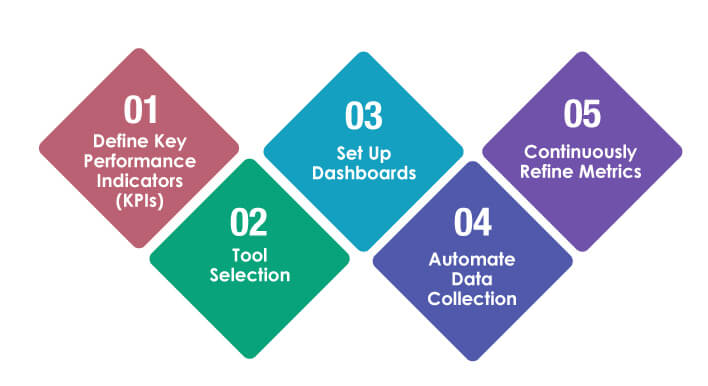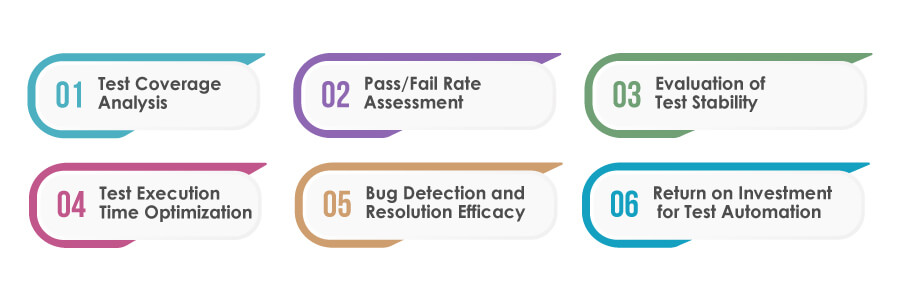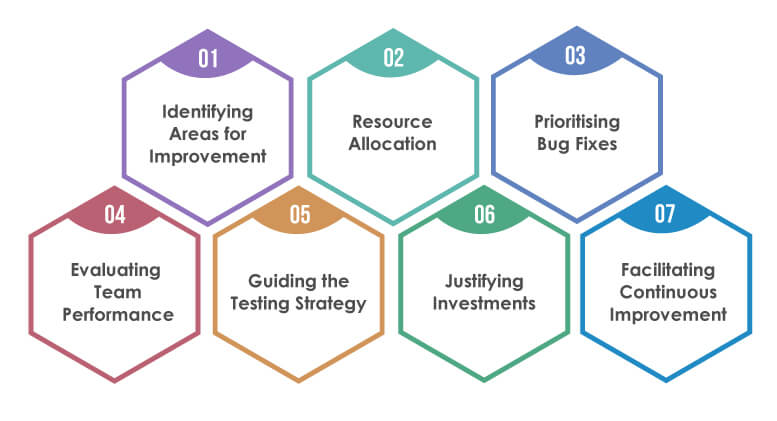Published: 08 Jan 2024
6 Key Metrics for Effective Test Automation Reporting Strategy
- Importance of Reporting in Automated Testing
- Integrating Metrics into Reporting Framework
- 6 Test Automation Reporting Metrics
- Role of Test Automation Reporting Metrics in Decision-Making
- Conclusion
- Why Partner with TestingXperts for Test Automation Services?
Businesses use automated testing to streamline development processes and ensure software quality. The software testing market is expanding significantly, with an anticipated CAGR of 7% through 2027, primarily due to advancements such as AI integration. With continuous innovation and efficiency analysis and reporting becomes its core. Effective test automation reporting shifts from mere technical necessity to a key strategic asset, converting data into actionable insights for improved decision-making and superior outcomes.
With 40% of testers reporting over a 50% acceleration in the testing process, the speed at which automated testing operates is revolutionizing the industry, making it a cornerstone of modern software development. This shift concerns speed, precision, and reach; automated testing promises increased coverage and accuracy, ensuring that products are delivered on time without sacrificing quality.
Importance of Reporting in Automated Testing
Automated testing is a fundamental process in software development that identifies defects and ensures applications function correctly. However, the absence of proper reporting can significantly diminish the value of even the most comprehensive automated tests. Effective reporting is essential as it turns raw test data into insightful information, explaining the results and their implications for the project.

Here’s why reporting is crucial in automated testing:
• It provides a clear view of test outcomes, making it easier to track progress and identify issues early on. Without reporting, stakeholders are blind to the successes and failures of the testing efforts.
• Effective reporting is a quality control mechanism that ensures defects are flagged and addressed promptly. It establishes a feedback loop that constantly improves product quality.
• With detailed reports, businesses can identify which tests consume the most resources and adjust accordingly, optimizing time and cost efficiency.
• High-quality reports equip decision-makers with the insights needed to lead the project direction. They can determine patterns, predict outcomes, and make strategic decisions based on comprehensive data.
• Reporting in automated testing fosters an environment of accountability, where every test run is documented, and its results are available for scrutiny, promoting transparency within the team and with stakeholders.
• By tracking test metrics over time, reports highlight trends and areas for improvement, serving as a roadmap for ongoing enhancement of the testing process.
Integrating Metrics into Reporting Framework
Implementing a comprehensive set of metrics into test automation reporting framework is a strategic approach to enhance the quality and efficiency of software development. This integration clarifies the impact of testing efforts and drives improvements through data-driven insights. An effective action plan is pivotal for a seamless integration.

To incorporate these metrics effectively, consider the following detailed action plan:
Define Key Performance Indicators (KPIs)
The primary step is establishing what metrics will serve as KPIs. These quantifiable measures will give insight into the performance and effectiveness of automated tests. Include test pass rates to indicate the application’s stability, bug detection rates to show the effectiveness of tests in identifying issues, and test coverage percentages to ensure all features are being tested. Ensure these KPIs align with broader organizational goals, such as reducing time to market, improving software quality, or increasing customer satisfaction.
Tool Selection
Select tools compatible with existing framework and which can accurately capture the chosen KPIs. Ensure these tools offer integration capabilities with other systems, like continuous integration pipelines or issue-tracking systems. Also, consider the scalability of the tools to support the growth of test suite and the complexity of projects.
Set Up Dashboards
Dashboards should be designed to provide real-time monitoring capabilities so that stakeholders can get an up-to-date view of the testing landscape. They should be customizable to focus on the most relevant KPIs for stakeholders, from QA engineers to executives. Also, ensure these dashboards are accessible to all relevant team members to promote transparency and collective ownership of quality.
Automate Data Collection
By automating the collection of KPI data, businesses can minimise manual errors and save time. Automated data collection ensures consistency in the reported data, which is crucial for tracking trends over time. It enables the prompt generation of reports, which is essential for agile teams making quick decisions.
Continuously Refine Metrics
As software and market conditions evolve, KPIs should remain relevant and aligned with testing objectives. Regularly request feedback from the team on the effectiveness of the metrics and adjust as necessary. Also, continuously benchmark performance against past data and industry standards to ensure competitiveness.
6 Test Automation Reporting Metrics
In test automation, effective reporting is not just about collecting data. It’s about selecting and analysing metrics to drive decision-making and improve software quality. These metrics are pivotal for understanding the current state of test automation measures and guiding future improvements. The following six metrics are essential for any robust test automation reporting strategy

Test Coverage Analysis
Test Coverage Analysis is a comprehensive evaluation of the extent to which automated tests validate the codebase and application features. It includes metrics such as functional coverage, code coverage, requirement coverage, and risk coverage. It’s essential to ensure that every critical function of the application is tested and potential gaps in the test suite are identified. Code coverage measures the proportion of the codebase executed by tests, indicating areas that may have been overlooked. Similarly, function coverage assesses whether all features have been tested, which is crucial for feature-ready software. These coverage metrics are vital for maintaining high software quality and can be increased by adding more tests or enhancing existing ones.
Pass/Fail Rate Assessment
The Pass/Fail Rate Assessment is an immediate measure of the success of automated tests. A high pass rate generally indicates that the application performs well against the test cases and is stable. Conversely, a high fail rate might signal issues with the code, such as bugs or integration errors, that need to be addressed. This metric can help prioritize fixes and identify areas with recurring problems. Tracking the pass/fail rate over time can also help detect trends in the codebase stability, allowing teams to predict and prevent future issues.
Evaluation of Test Stability
Evaluation of Test Stability focuses on the reliability of test results. Tests should consistently yield the same outcome under the same conditions. Unstable tests can deteriorate trust in testing processes and waste valuable time in the development cycle. Consistently stable tests are a sign of a robust test suite. Identifying unstable tests and rectifying the root causes is essential to ensure that automated testing provides reliable feedback, which is crucial for continuous integration and delivery practices.
Test Execution Time Optimization
Test Execution Time Optimization is about ensuring that the test suite runs efficiently. Long test execution times can bottleneck the development process, delaying feedback to developers and prolonging the release cycles. This metric is crucial for identifying tests that could be optimized for speed without compromising their effectiveness. By minimizing the execution time, teams can achieve more frequent and faster iterations, a cornerstone of agile and DevOps methodologies.
Bug Detection and Resolution Efficacy
Bug Detection and Resolution Efficacy measures the capability of automated tests to identify defects and the team’s efficiency in resolving them. The primary goal of automated testing is to find and fix bugs early in the development process, reducing the risk of costly post-release patches. Tracking how many bugs are caught by the automated tests and the time taken to resolve these bugs offers insight into the quality of the testing suite and the software being tested. A high detection rate and swift resolution times reflect a mature and effective development process.
Return on Investment for Test Automation
Return on Investment (ROI) for Test Automation evaluates the financial effectiveness of the automated testing efforts. It includes metrics such as test automation cost, test automation savings, test automation quality impact, and test automation business value. Calculating the ROI involves analysing the costs associated with the automated testing process against the benefits it brings. Costs include tooling, resources, and maintenance, while benefits may encompass reduced manual testing hours, lower bug rates in production, and improved team morale. A positive ROI indicates that the investment in automated testing yields substantial benefits, making it a valuable component of the software development lifecycle.
Role of Test Automation Reporting Metrics in Decision-Making
Test automation reporting metrics are critical in the decision-making process for software development and quality assurance teams. They provide quantifiable data that can inform various aspects of software production, from pinpointing areas requiring immediate attention to strategizing future development paths. By leveraging these metrics, teams can make informed, objective decisions that align with their quality objectives and business goals. The roles these metrics play in decision-making include

Identifying Areas for Improvement
Metrics such as code coverage and function coverage are necessary for identifying areas within the application that may be under-tested or prone to defects. For instance, if specific modules consistently show a lower pass rate or higher bug count, it indicates a need for increased testing or a potential code repair. This allows development and QA teams to strategically focus their efforts on enhancing those areas, thereby improving the overall quality of the application.
Resource Allocation
Analysis of pass/fail rates and bug detection rates provides a clear picture of the testing landscape, helping management determine where additional resources are needed. For example, allocating more developers or testers to those areas may be necessary if a particular set of features consistently fails or yields bugs. Conversely, areas with consistently high pass rates may require less frequent testing, allowing businesses to redirect resources to more critical tasks.
Prioritising Bug Fixes
Metrics related to bug detection and resolution times are vital for establishing the urgency of bug fixes. They help categorise bugs by severity and impact, enabling teams to tackle the most critical issues first. This approach ensures that high-impact bugs do not make it into production, which can save the organisation from potential downtime, customer dissatisfaction, and financial losses.
Evaluating Team Performance
Automated reporting metrics provide insights into the performance and efficiency of individual team members and the team as a whole. This data can be used to recognise high performers, identify areas where team members may need additional training or support, and make informed decisions about process improvements to enhance productivity and efficiency.
Guiding the Testing Strategy
By examining trends in test stability and execution time, organisations can make informed strategic decisions regarding their testing processes. For example, consistently long test execution times may prompt a review of the automation framework, leading to adopting more efficient tools or methods. Similarly, trends in test stability can inform decisions about the focus areas for enhancing test reliability.
Justifying Investments
The ROI of test automation is a crucial metric for understanding the value it brings to an organisation. By quantifying the benefits, such as time saved on manual testing and the reduction of bugs found after release, stakeholders can make a compelling case for continued or increased investment in test automation tools and practices.
Facilitating Continuous Improvement
Regular reviews of test automation metrics enable a culture of continuous improvement within the organisation. By making decisions based on historical data and identified trends, teams can iteratively refine their testing processes. This ongoing refinement leads to a more mature testing process and a higher-quality product.
Conclusion
In conclusion, integrating key metrics such as test coverage, pass/fail rates, test stability, execution time, bug detection efficiency, and ROI into test automation reporting is crucial for informed decision-making. These metrics highlight the effectiveness of QA efforts, guide resource allocation, and prioritise bug fixes, ultimately contributing to a more efficient and reliable software development lifecycle. Implementing these metrics into the reporting strategy will streamline processes and enhance the overall quality of software products.
Why Partner with TestingXperts for Test Automation Services?
Choosing TestingXperts for your test automation services ensures you partner with a quality assurance and testing innovation leader. Our commitment to excellence sets us apart from the competition and positions us as the preferred partner for businesses looking to enhance their software quality through effective test automation.

Our Key Differentiators:
At TestingXperts, we understand that each client has unique needs. Our bespoke test automation services are designed to meet your requirements, ensuring a perfect fit for your business.
• Leveraging the latest test automation technology, we provide cutting-edge solutions that keep you ahead in a rapidly evolving digital landscape.
• Our team comprises industry-certified experts who bring knowledge and experience to your projects, delivering results that exceed expectations.
• We employ proven methodologies refined through years of practice, guaranteeing a systematic approach that enhances test efficiency and effectiveness.
• Our rigorous testing process ensures that every aspect of your application is thoroughly tested for performance and reliability.
• Our clients are kept in the loop at every stage, with clear reporting and open lines of communication.
• Our visual representation in reports allows clients to process a lot of data much faster as well as provides a quick rundown of what has been done with their money.
• Our in-house accelerator, Tx-Automate, streamlines your testing process, reduces time-to-market, and provides a flexible, scalable solution for all your automation needs.
To know more, contact our QA experts now.